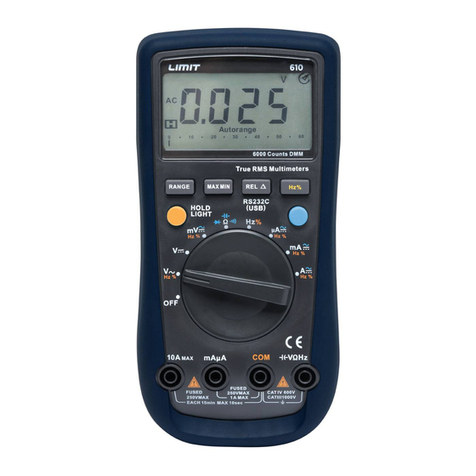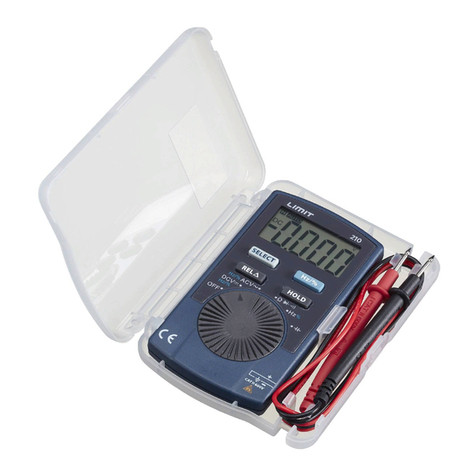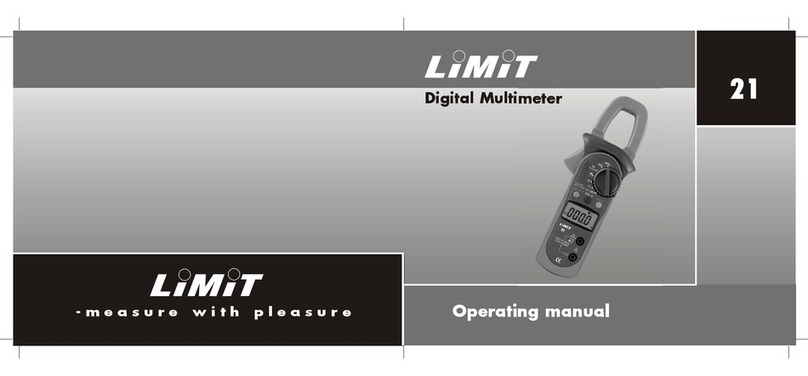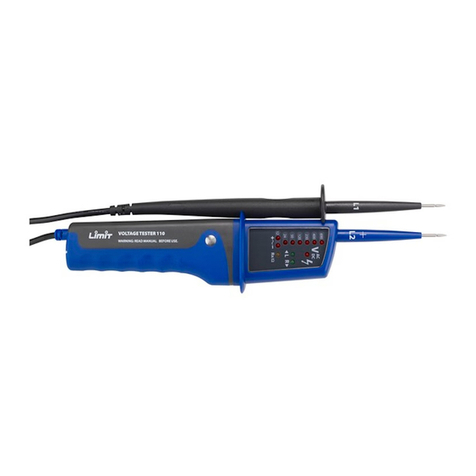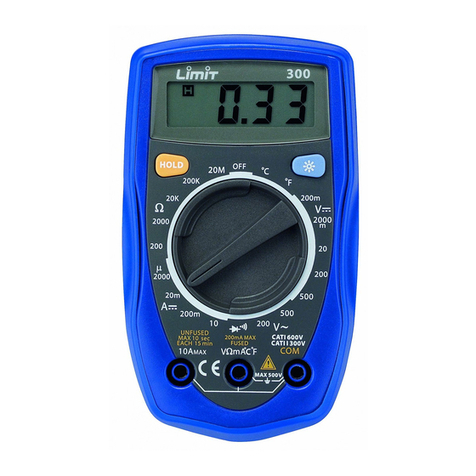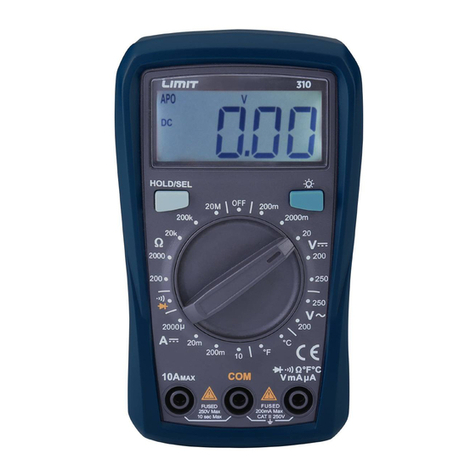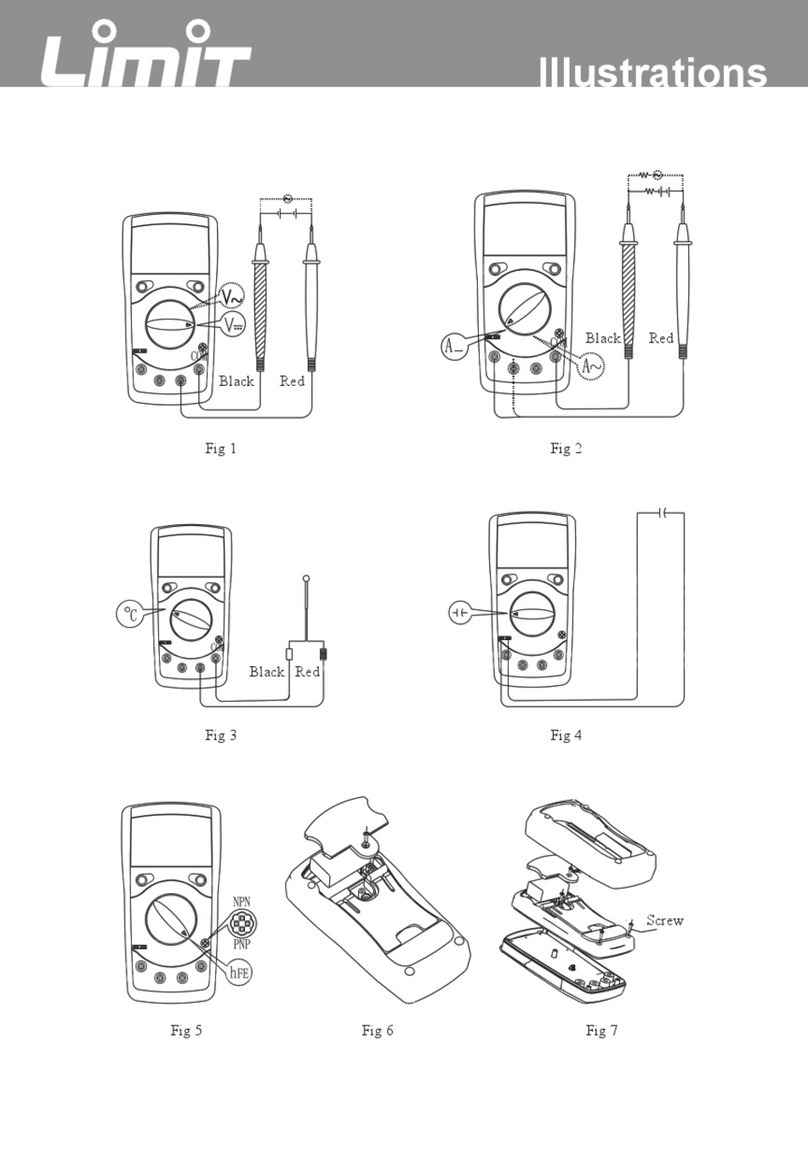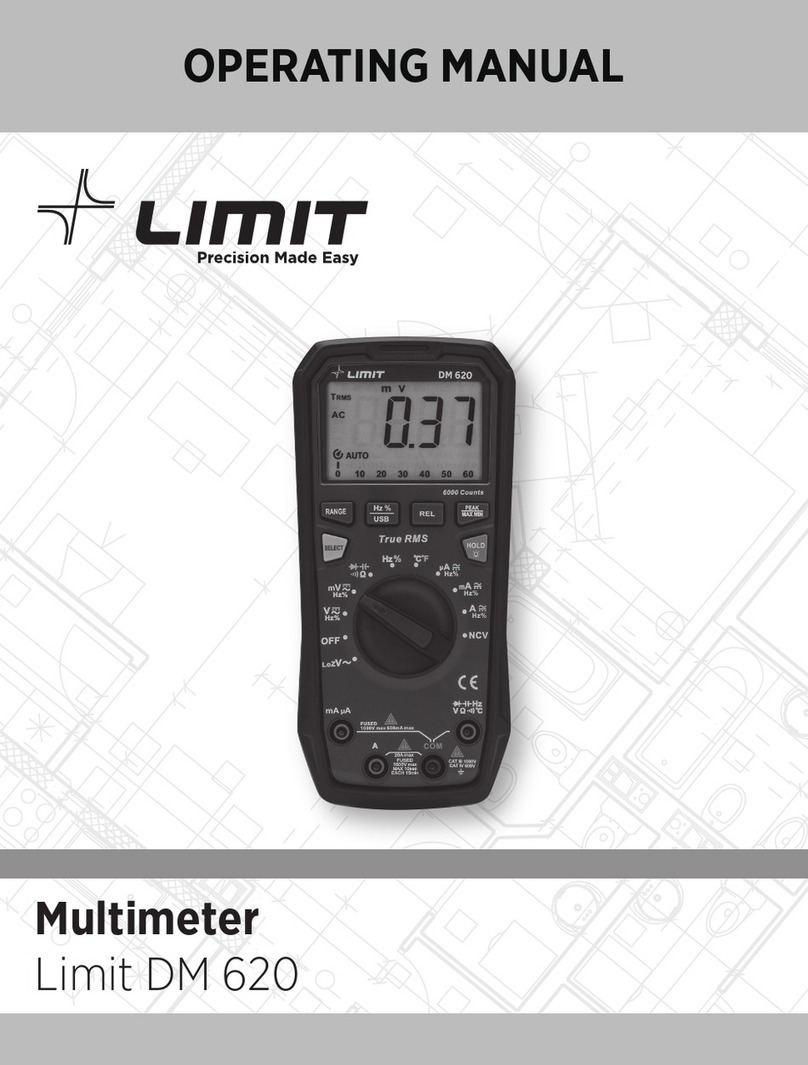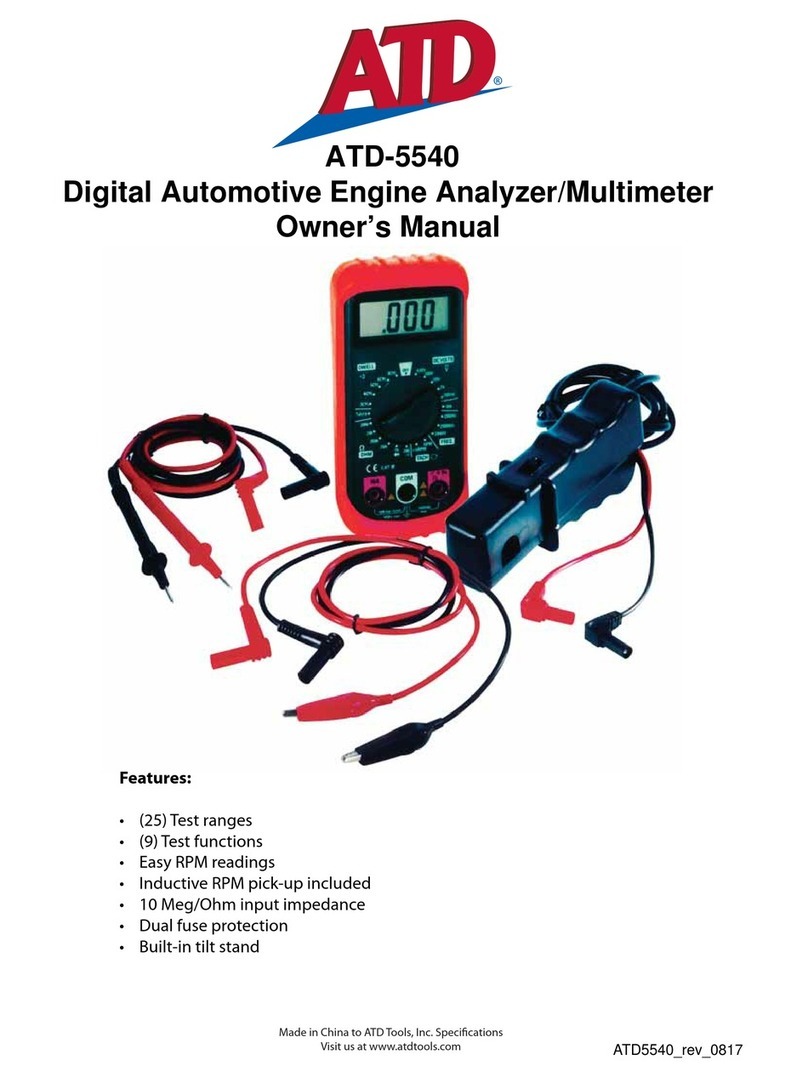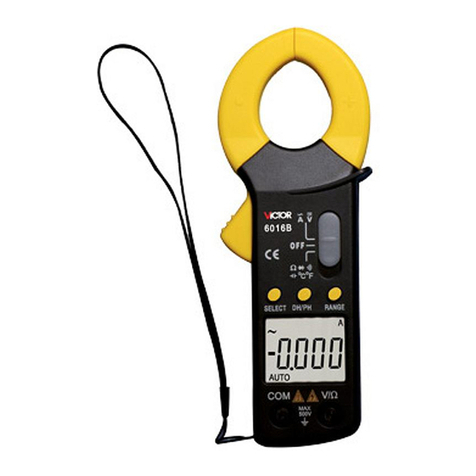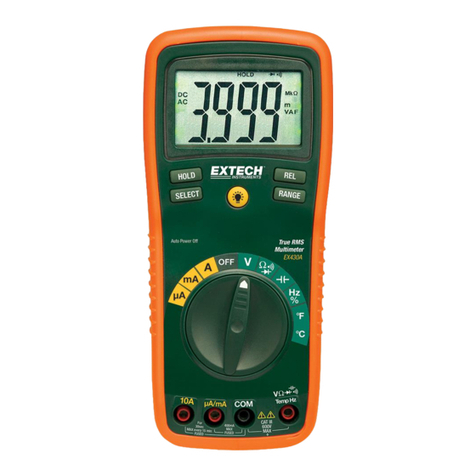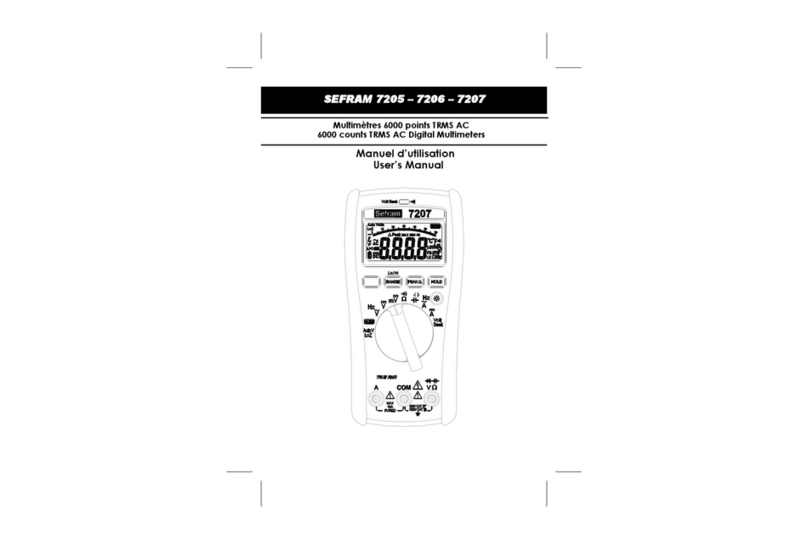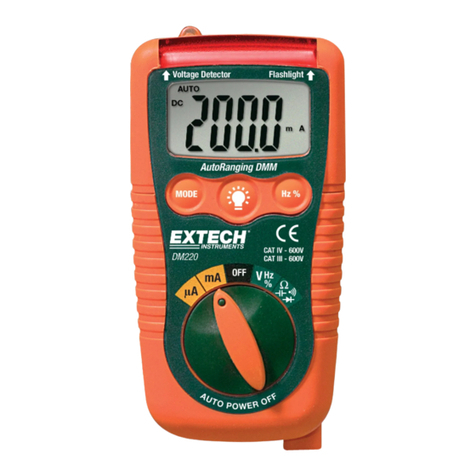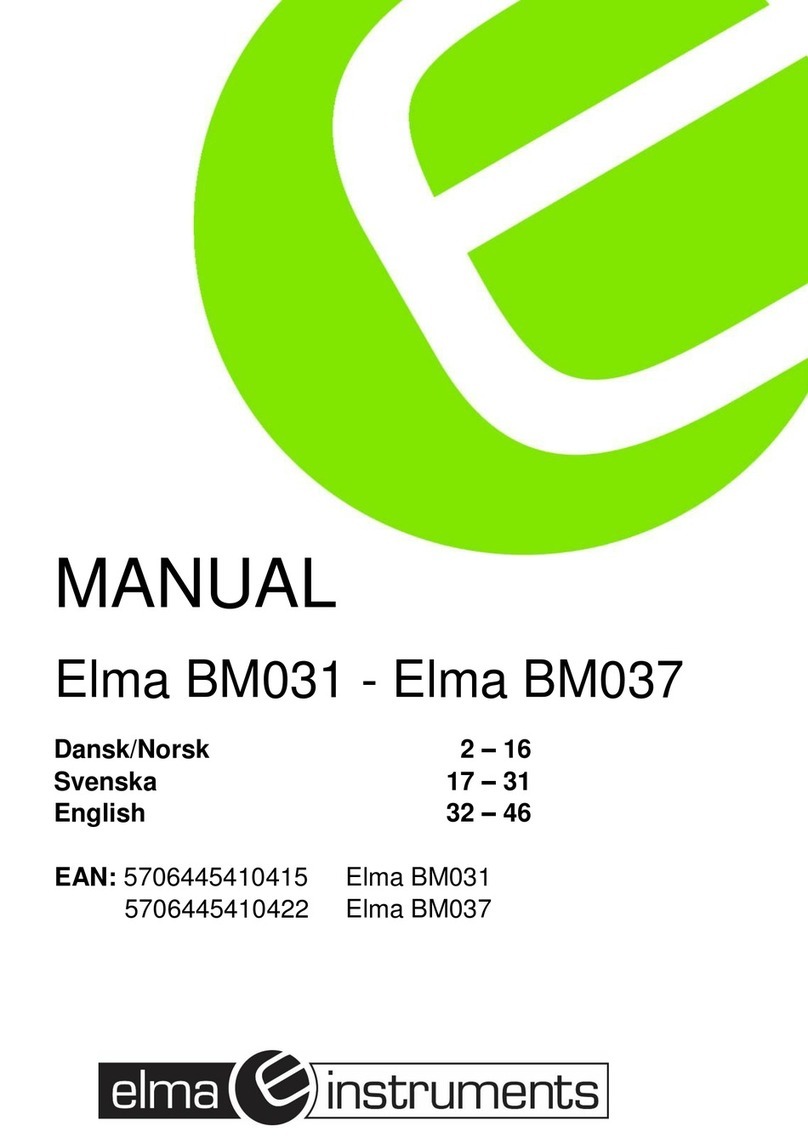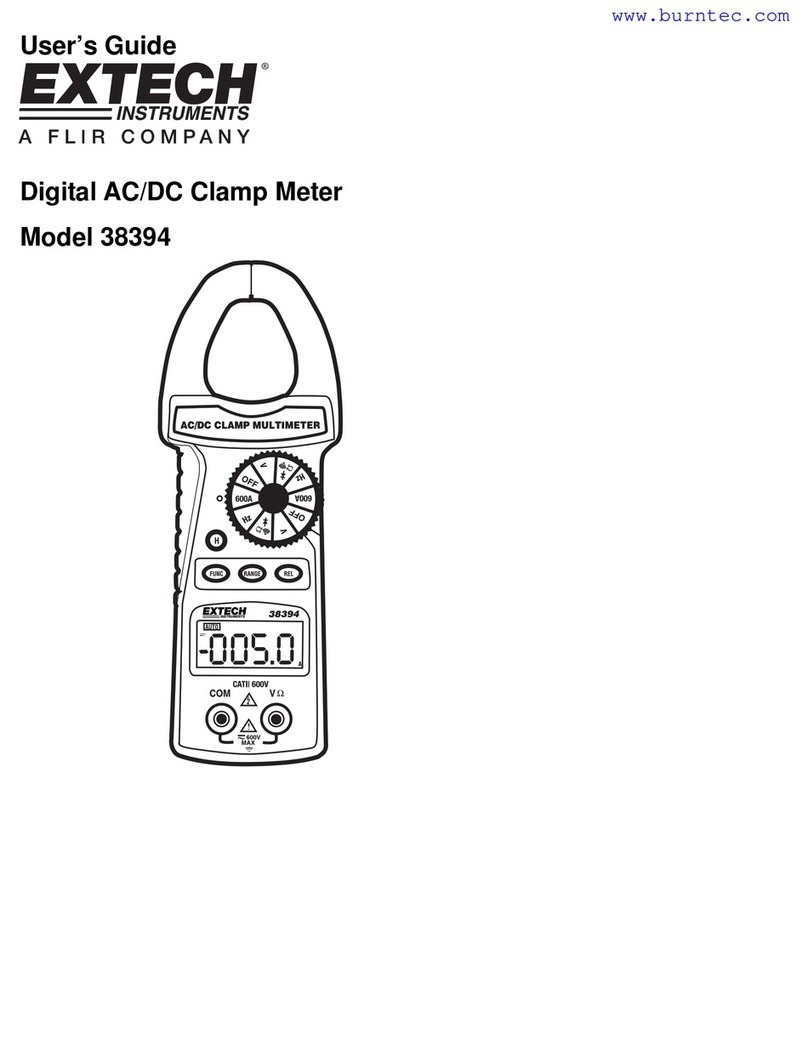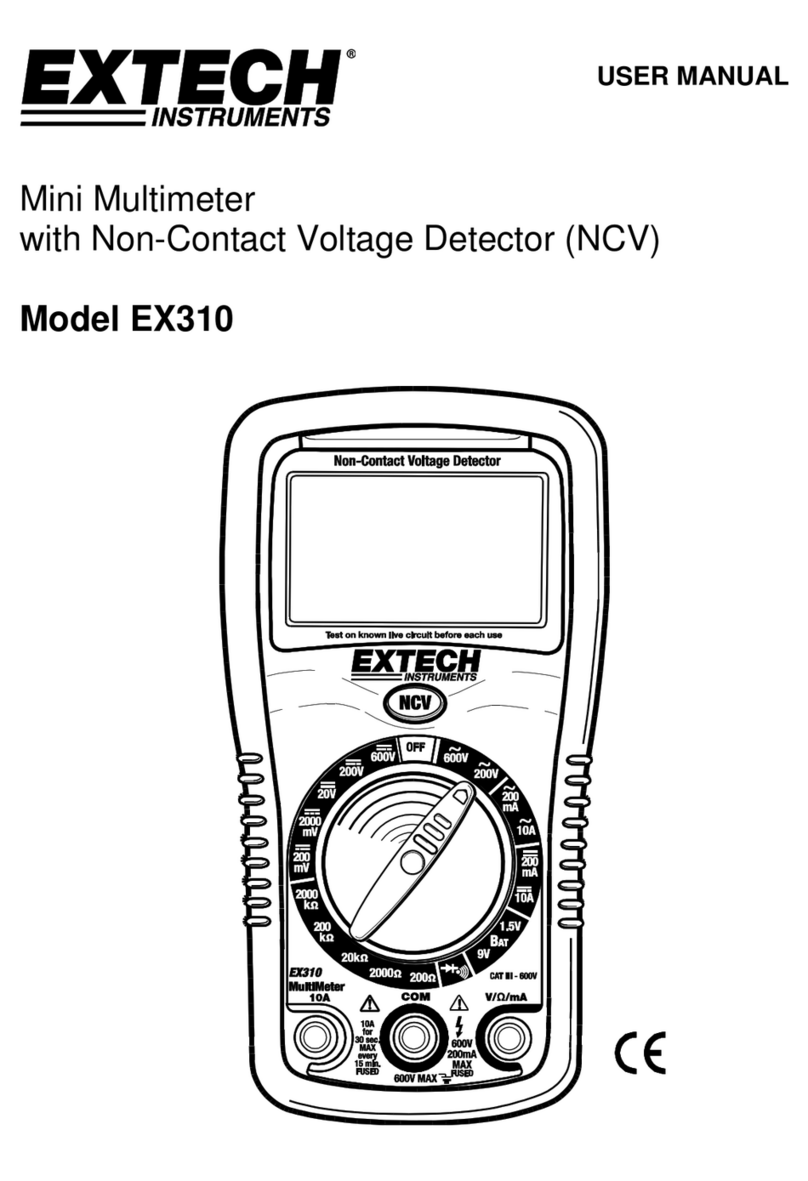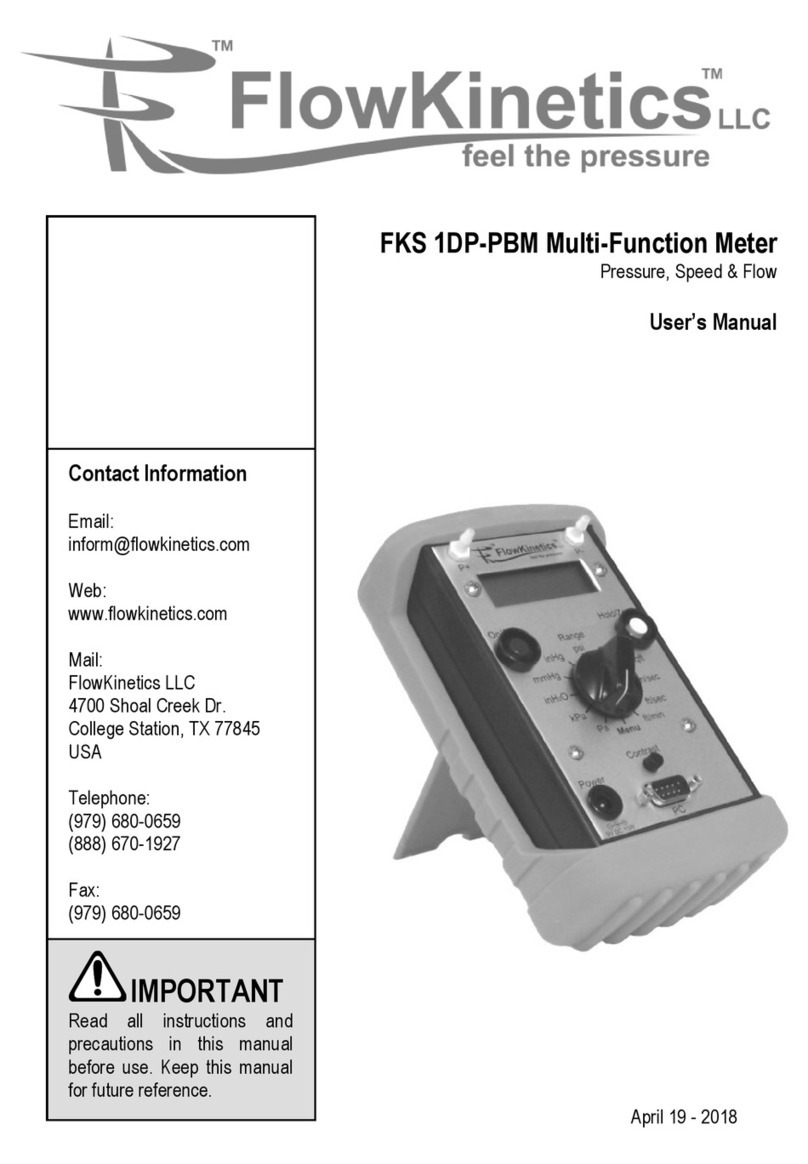LIMIT 23 User manual

23

23

Red Black
Red Black
fig.1. DC/AC Voltage Measurement
Red Black
fig.2. Measuring Resistance
fig.3. DC Current Measurement
fig.4. Replacing the Battery
1
Illustrations

23
A. DC Voltage
Range
6.600V
66.00V
600.0V
Resolution
1mV
10mV
100mV
Accuracy
(0.8%+1)
Overload protection
600V DC/AC
B. AC Voltage
Range
6.600V
66.00V
600.0V
Resolution
1mV
10mV
100mV
Accuracy
(1.2%+5)
Overload protection
600V DC/AC
C. Resistance
Range
660.0Ω
6.600kΩ
66.00kΩ
660.0kΩ
6.600MΩ
66.00MΩ
Resolution
0.1Ω
1Ω
10Ω
100Ω
1kΩ
10kΩ
Accuracy
(1.2%+2)
(1%+2)
(1.2%+2)
(1.5%+2)
Overload protection
250VAC
2

D. Diode Test
Range Resolution
1mV
Accuracy
0.5V~0.8V (Open
circuit voltage
approx. 3.0V)
Overload protection
250VAC
E. Continuity Test
Range Resolution
0.1
Accuracy
Around 30Ω,the
buzzer beeps.
(Open circuit voltage
approx. –1.2V)
Overload protection
250VAC
3
Tables

23
F. Frequency
Range
660.0Hz
6.600kHz
66.00kHz
660.0kHz
6.600MHz
66.00MHz
Resolution
0.1Hz
0.001kHz
0.01kHz
0.1kHz
0.001MHz
0.01MHz
Accuracy
(0.1%+3)
Overload protection
250VAC
G. Duty Cycle
Range
0.1%~99.9%
Resolution
0.1%
Accuracy
For reference only
Overload protection
250VAC
H. DC Current
Range
66.00A
1000A
Resolution
0.01A
1A
Accuracy
(1.5%+40)
(1.5%+8)
Overload protection
1000A DC/AC
4

I. AC Current
Range
66.00A
1000A
Resolution
0.01A
1A
Accuracy
(2%+40)
(2%+8)
Overload protection
1000A DC/AC
Frequency
Response
50Hz ~ 60Hz
5
Tables

Language Contents
Language page
English····················································································7-15
Svenska················································································16-23
Norsk·····················································································24-31
Dansk····················································································32-39
Suomi····················································································40-47
Deutsch·················································································48-58
Nederlands···········································································59-67
Français················································································68-76
Italiano ··················································································77-86
Español·················································································87-95
Português ···········································································96-104
Ελληvikά···········································································105-114
Polski ················································································115-125
Eesti ··················································································126-134
LietuviŠkai·········································································135-144
Latviski··············································································145-154
Pycckий ············································································155-165
6
English

Contents
Overview
General specification
Safety information
Voltage DC and AC
Current DC
Current AC
Resistance
Frequence and Duty cycle
Diodes test
Continuity test
Battery
7
English

8
Overview
This Operating Manual covers information on safety and cautions. Please read
the relevant information carefully and observe all the Warnings and Notes strictly.
Limit 23 is a clampmeter/multimeter for professional use. The instrument have
autorange and the display have large digits, shows rotary switch position witch
makes this instrument easy to handle for the user. For indoor use.
General Specifications
Measuring range and accuracy see page 2-5.
• Auto range.
• Display shows selected function.
• Maximum Display: 6666 or 3 5/6 digits.
• True RMS for Voltage AC.
• Surge current Current AC.
• Displays shows OL when the instrument is overloaded.
• Max conductor diameter for clamp 45 mm.
• Display backlight. Automatic off after1 minute.
• Sleep mode. Instrument turn off automatic if not active for 15 minutes. Beeps 3
times before turn off.
English

9
• Measurement Speed: Updates 3 times /second.
• Temperature: Operating: 0°C~30°C
Storage: -20°C~60°C
• Battery 1 pcs 9 V Type 6F22.
• Safety/Compliances: IEC61010 CAT II 600V/ CAT III 300 V over voltage and
double insulation standard.
• Certification: CE
Safety Information
This Meter complies with the standards IEC61010: in pollution degree 2,
category CAT II 600V, CAT III 300V over voltage and double insulation.
Warning
To avoid possible electric shock or personal injury, and to avoid possible
damage to the Meter or to the equipment under test, adhere to the following
rules:.
• Before using the Meter inspect the case. Do not use the Meter if it is damaged
or the case (or part of the case) is removed. Look for cracks or missing plastics.
Pay attention to the insulation around the connectors.
English
English

10
• Inspect the test leads for damages insulation or exposed metal. Check the test
leads for continuity.
• Do not apply more than the rated voltage, as marked on the Meter, between
the terminals or between any terminal and the grounding.
• The rotary switch should be placed in the right position and no any changeover
of range shall be made during measurement is conducted to prevent damage of
the Meter.
• Never attempt an in-circuit current measurement where the voltage between
terminals and ground is greater than 600 V.
• When the Meter working at an effective voltage over 60V in DC or 42V rms in
AC, special care should be taken for there is danger of electric shock.
• Do not use or store the Meter in an environment of high temperature; humidity,
explosive, inflammable and strong magnetic fields. The performance of the
Meter may deteriorate after dampened.
• When using the test leads, keep your fingers behind the finger guards.
• Disconnect circuit power and discharge all high-voltage capacitors before
testing resistance, continuity, diodes and current.
• Replace the battery as soon as the battery indicator appears. Whit to low
battery, the Meter might produce false readings that can lead to electric shock
and personal injury.
English

11
Functional buttons
Select • Change between DC and AC for voltage and current
measurement.
• Change between resistance, continuity and diod test.
MAX/MIN • Starts recording of maximum and minimum values. Press button
for 1 second to exit max/min mode.
☼• ON/OFF for display backlight. Backlight automatic off after 1
minute.
Hold • ON/OFF for hold function. H shows on display when value is
frozen.
θHz • Change between Hz and duty cycle % when the meter is at %Hz,
V or A position.
ZERO • Zeroing the display before measuring DC current.
Voltage measurement DC and AC (See fig 1)
1. Insert red test lead into the VΩHz terminal and black test lead into the COM
terminal.
2. Set the rotary switch to V position.
3. Select DC or AC with select button. Display shows DC or AC.
4. Connect the test leads across with the object being measured. The measured
value shows on the display.
English
English

Current measurement DC (See fig 3).
1. Set the rotary switch to 66 Aor 1000 A.Display shows DC. Start with 1000
A when the value is unknown.
2. Open the jaws and center one of the conductor. Make sure the conductor is
placed at center of the jaw. Only one conductor at each time can be measured.
The measured value shows on the display.
Note. If the meter not display 00,00 when it is at 66 Arange press zero
button to zeroing.
When the meter is at 1000 Arange it displays 0 and it is not allowed to press
zero button.
Current measurement AC (See fig 3).
1. Set the rotary switch to 66 A~ or 1000 A~ .Display shows AC. Start with 1000
A when the value is unknown.
2. Open the jaws and center one of the conductor. Make sure the conductor is
placed at center of the jaw. Only one conductor at each time can be measured.
The measured value shows on the display.
Surge current measurement
1. Set the rotary switch to 1000 A~ .
2. Press select button when the meter display minimum reading. The display
value shows ---- and INRUSH symbol.
2
12
English

13
3. Turn on the electrical equipment to measure the moment start up current. The
meter is locked to the highest measurement range.
4. Press select button for 1 second to exit surge current mode.
Resistance measurement (See fig 1)
1. Insert red test lead into the VHz terminal and black test lead into the COM
terminal.
2. Set the rotary switch to position.
3. Push select button to select resistance function. Displays shows .
4. Connect the test leads across with the object being measured. The measured
value shows on the display.
Note
• The test leads can add 0.1to 0.3of error to resistance measurement. To
obtain precision readings in low-resistance measurement, that is the range of
200, short-circuit the input terminals beforehand and record the reading
obtained. This is the additional resistance from the test lead.
• OL displays when the circuit is open or the resistor value is higher than max
range.
Frequency and Duty Cycle measurement (See fig 2)
1. Insert red test lead into the VHz terminal and black test lead into the COM
terminal.
English

14
2. Set the rotary switch to %Hz position.
3. Push θHz button to select Hz or Duty Cycle function. Displays shows Hz or %.
4. Connect the test leads across with the object being measured. The measured
value shows on the display.
5. When meter is on V or A measuring mode frequency or duty cycle can be
measured by pushing θHz button.
Diode test (See fig 2)
Use the diode test to check diodes, transistors, and other semiconductor devices.
The diode test sends a current through the semiconductor junction, and then
measures the voltage drop across the junction. A good silicon junction drops
between 0.5V and 0.8V.
To test a diode out of a circuit, connect as follows:
1. Insert red test lead into the VΩHz terminal and black test lead into the COM
terminal.
2. Set the rotary switch to diode position.
3. Push select button to select diode function. Displays shows diode symbol.
4. For forward voltage drop readings on any semiconductor component, place
the red test lead on the component’s anode and place the black test lead on
the component’s cathode.
The measured value shows on the display.
English

15
Continuity test (See fig 2)
To test for continuity, connect as follows:
1. Insert red test lead into the VΩHz terminal and black test lead into the COM
terminal.
2. Set the rotary switch to continuity position.
3. Push select button to select continuity function. Displays shows continuity
symbol.
4. Connect the test leads across with the object being measured. The buzzer
sounds if the resistance of a circuit under test is between 30Ω.and 100Ω.
Replacing the Battery (See figure 4)
Replace battery as soon battery symbol is shown on display.
1. Disconnect the connection between the testing leads and the circuit under test
when battery indicator appears on the display.
2. Turn the Meter to OFF position.
3. Remove the screw, and separate the battery lid.
4. Replace the battery with 1 pcs 9 V Type 6F22.
5. Rejoin the battery lid and the screw.
English
Table of contents
Other LIMIT Multimeter manuals
